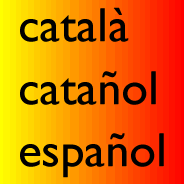
In bilingual communities it is common to switch between languages regularly. This certainly happens a lot among the Welsh speakers I know and hear every day.
Some conversations are mostly in Welsh with occasionally bits of English every so often, some are mainly in English with some bits of Welsh, and some regularly weave between Welsh and English.
According to a friend, it might not be so common for Catalan speakers to mix Catalan and Spanish. He is learning Spanish, and also knows a bit Catalan, and plans to learn more. He believes that Catalan speakers either speak one or the other, and don’t usually mix them in one conversation. So if he went to Barcelona and spoke the little Catalan he knows mixed with Spanish, people might find this strange. Is he correct?
According to the Urban Dictionary, Catañol is the mixture of Catalán and Español that people in Catalán-speaking areas of Spain often use to converse.
According to the Wikipedia, Catañol is spoken in Barcelona, especially by young people, and is a form of Spanish with Catalan influences. It emergered during the 20th century as a result of migration to Catalonia from other parts of Spain. It is apparently considered ‘vulgar’.
Are there any bilingual or multilingual communities where language mixing is rare or even stigmatised?
I am not sure how “rare” it might be (if I understood the meaning of the article) but here in New Brunswick Canada there is a mixture called “chiac” stemming from the place name Shediac NB where one hears it. It is a mixture of English and Acadian French and an example one often hears concerns a woman who had altered her dress and didn’t like the outcome so she exclaimed “J’ai arrangé le hem de ma skirt mais asteur je n’aime pas le way qu’a hang.” “Asteur” is a contraction of ” à cette heure”. If you Google the Acadian band “1775” which s popular in the 1970’s and listen to their song “CB Buddy” it’s a good example. Chiac is somewhat stigmatized but mostly by pedants. It’s actually quite cool!
Spanglish is common in some situations (tune in a radio traffic report in San Antonio sometimes), but by no means always. Spanish speakers who are trying to follow the path of learning English fluently will rarely mix Spanish in unless talking to their families, and then they may use only Spanish.
A very important example is Portuñol, used by Portuguese speakers to make themselves intelligible to Spanish speakers. In general they have little trouble understanding Spanish, but Spanish speakers find spoken Portuguese unintelligible, especially in Portugal (Brazilian is a bit easier). To speak Portuñol you use the Spanish word if you happen to know it, you pronounce all the vowels (not reducing most of them to schwas), and you change endings to their Spanish equivalents, like -ção to -ción for example..
Extremely interesting post. I learnt Spanish in a very academic/grammatical way (in UK). But my lived experience has been in Catalunya- where it is all Catalan which I have absorbed but never ever studied formally. Result: I mix. But I have noticed that locals stick to one or the other (never mix) and are bemused at the hybrid I produce.
I’m a native English speaker living and working in Oslo. I work among many Swedes and it’s said that they speak Svorsk (Swedish+Norwegian), which in reality is just Swedish with Norwegian vocabulary items that are different from Swedish. I’ve now studied Norwegian and speak it fluently however many locals think I’m a Swede who has studied in Norway, as I tend to “sing” my speech to a Swedish “tune” rather than a Norwegian one.
I should also note that my Swedish-tainted Norwegian was often frowned upon by the upper class Norwegians, who exclaimed on a few occasions “Oh just speak Swedish already!”. However as soon as they find out I’m not European, they suddenly find my Norwegian “cute”.